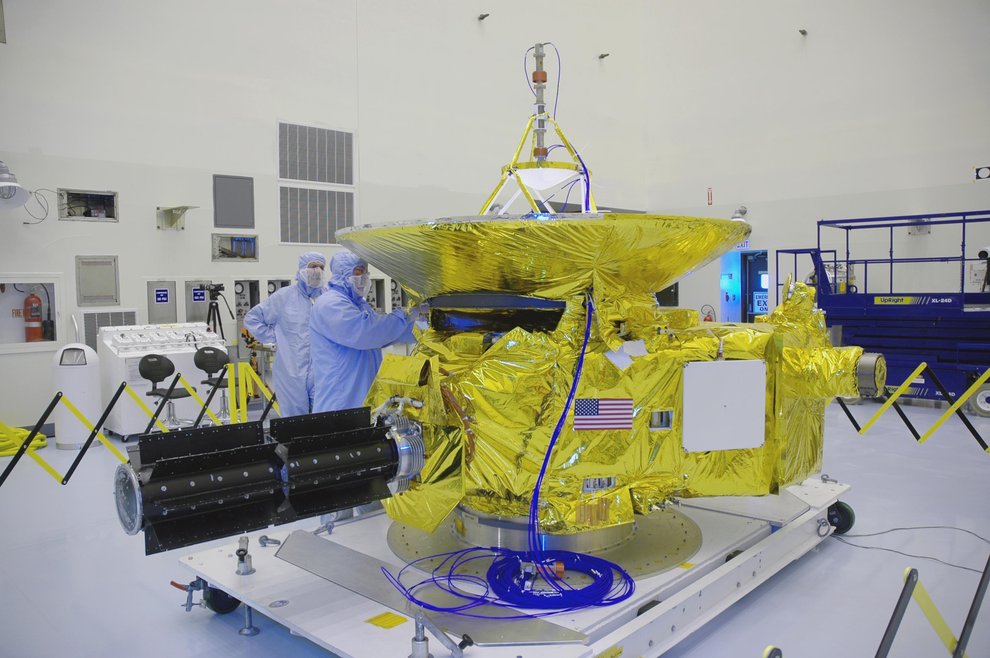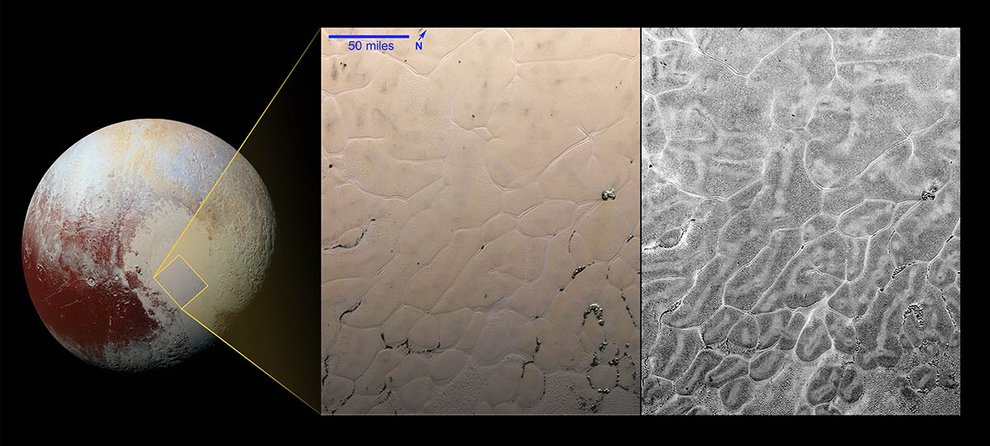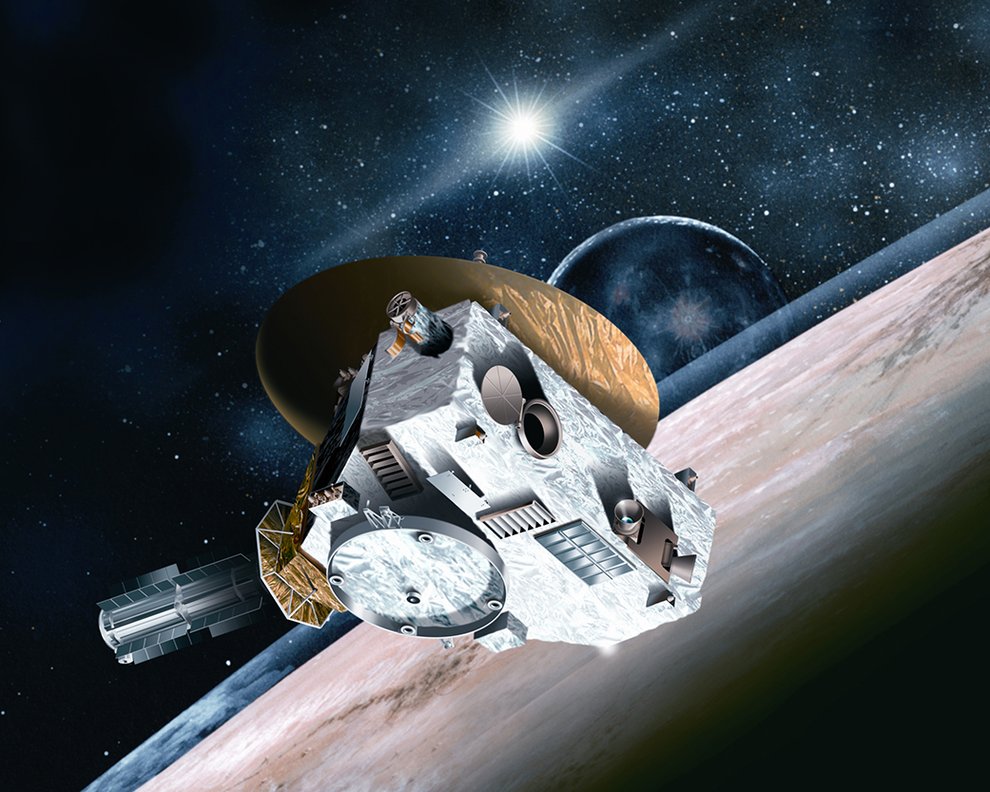New Horizons is Approaching Ultima Thule. Here’s What You Need to Know.
In preparation for the New Year’s Day flyby, catch up on the spacecraft’s 13-year journey through our solar system—and what might be up ahead.

An artist's impression of NASA's New Horizons spacecraft encountering 2014 MU69, a Kuiper Belt object better known by its nickname, Ultima Thule. The flyby is scheduled to occur on January 1, 2019. Image Credit: NASA/Johns Hopkins University Applied Physics Laboratory/Southwest Research Institute
Space may be the final frontier—but luckily for us, its horizons are ever expanding.
At 12:33 a.m. EST on January 1, NASA’s New Horizons spacecraft will make its closest approach to the enigmatic Kuiper Belt object Ultima Thule, just a few days shy of the thirteenth anniversary of the space probe’s initial launch in 2006. If the flyby is successful, Ultima Thule will become the farthest object in the Solar System humanity has explored so far—and perhaps the most primitive.
The New Horizons mission is only just entering its teens, but the team of scientists, engineers, and personnel behind it at NASA can already boast a lifetime’s worth of staggering findings from the spacecraft’s tenure abroad. As New Horizons continues to close the gap between itself and Ultima Thule, here’s what you need to know to get caught up.
Ultima Thule could be a time capsule of clues about the birth of our solar system.
Ultima Thule (pronounced too-lee) is a small, mysterious object in the Kuiper Belt, the region of our solar system that lies beyond Neptune. The object’s official title is actually much less glamorous—2014 MU69—but its more catchy nickname, Latin for “beyond the known world,” is fitting: Ultima Thule is a whopping 4 billion miles away from Earth.
This strange little object is believed to be one of many icy relics of the formation of the Solar System 4.6 billion years ago. In the chaos of giant planets coming together, a few bits and pieces didn’t make the cut; basically, Kuiper Belt objects like Ultima Thule are akin to the doughy bits left over from making biscuits. Studying pristinely preserved scraps like Ultima Thule—which has probably been orbiting the Sun more or less undisturbed since its inception—might just yield some insights into the birth of our own world.
“We think that by looking at Ultima Thule today, we’re really looking backwards in time 4.6 billion years ago,” says New Horizons Project Scientist Hal Weaver.

In the clean room at Kennedy Space Center's Payload Hazardous Servicing Facility, technicians prepare the New Horizons spacecraft a few months prior to its launch in January 2006. Image Credit: NASA
Though New Horizons has been careening Thule-ward for several years now, only a couple tantalizing tidbits about Ultima Thule have actually surfaced. For one thing, we know it’s a teeny little thing, only about 20 miles wide—the size of an earthbound city. And, billions of miles from the Sun, this ruddy outcrop is a frigid freckle of rock and ice: According to Weaver, Ultima Thule’s surface temperature may hover around 35 Kelvin (that’s about -397 degrees Fahrenheit, and chillingly close to absolute zero, the lowest temperature that’s theoretically possible).
Most answers, however, are still sorely lacking. Scientists aren’t even sure if Thule is just one object; it could actually be two, circling each other in a tight tango. But as New Horizons readies itself for its closest approach, the hope is that a few longstanding questions about the object—and our solar system as a whole—will finally be put to rest.
“I suspect I’m going to be totally surprised by what we see at Ultima Thule,” says Alice Bowman, the Mission Operations Manager (or MOM for short) of New Horizons. “I don’t have any predictions—I’m just curious.”
Ultima Thule wasn’t New Horizons’ first destination—and it may not be its last.
When New Horizons jetted away from Cape Canaveral in 2006, its most explicit objective was to explore the then-planet Pluto, another member of the Kuiper Belt. But NASA kept its lens as wide as possible: Even without a second target set, the space probe was juiced with extra fuel for another flyby.
It took nearly a decade for New Horizons to bridge the 3-billion-mile gap between Earth and Pluto and its moon Charon (during which Pluto was dramatically, and controversially, demoted to the status of dwarf planet), but it certainly didn’t squander the journey. The spacecraft made a quick pit stop at Jupiter in 2007 to scope out the planet and its volcanic moon Io. Swinging by Jupiter also allowed New Horizons to conduct a quick gravity assist—a maneuver that capitalized on the planet’s gravity to slingshot the probe toward Pluto with extra momentum.
But Pluto was the first big reveal. The images streaming in from New Horizons after its July 2015 encounter unveiled a diverse terrain of mountains, dunes, craters, and plains on Pluto, with the surprising youth of some features even suggesting recent geologic activity. One of Pluto’s most notable discoveries was a volatile reservoir of nitrogen ice contained within a prominent heart-shaped pockmark. The frozen basin, which has since been christened Sputnik Planitia, extends for thousands of miles over Pluto’s surface. Sputnik Planitia’s hefty hoard of nitrogen is thought to feed the dwarf planet’s atmosphere; Weaver likes to call it “the source of Pluto’s mojo.”
Of course, there’s far more to the story. Next summer, a scientific conference will convene to discuss the latest on Pluto—so stay tuned.

Sputnik Planitia—the western half of Pluto's heart—is full of vast plains of nitrogen ice. The images above show two different versions of the same region within Sputnik Planitia, revealing intricate patterns that could indicate how ice flows and shifts on the dwarf planet's surface. Image Credit: NASA/Johns Hopkins University Applied Physics Laboratory/Southwest Research Institute
And past Ultima Thule, there is even more to explore. According to Weaver, New Horizons has enough power and fuel to chug along into the 2030s, barring any unforeseen complications. “This will be the only mission to the Kuiper Belt in my lifetime,” he says. “And it takes decades for these things to happen… We want to squeeze as much science as we can out of the New Horizons mission.”
This means that New Horizons may yet make another stop, pending approval from NASA. The path forward isn’t set, but the New Horizons team is eager to keep exploring—and possibly add another notch to their Kuiper Belt.
Pluto was tough. Ultima Thule presents its own set of challenges.
We’ve known about Pluto since 1930 (and for most of its existence in the eyes of humankind, it was a planet). Even though New Horizons didn’t achieve liftoff until eight decades later, in a way, scientists have been exploring Pluto for nearly a century. Ultima Thule, on the other hand, is quite literally uncharted territory. In the span of four years, the New Horizons team has had to put together a flight plan, assemble its operations, and strategize data collection for the new flyby—all while preliminary observations of Ultima Thule were still being made. And New Horizons hasn’t gotten any younger since its Pluto days.
“I feel like we’ve been racing towards the finish line,” Bowman says.
The New Horizons team has certainly leveraged its experiences with Pluto, Bowman adds, but in many ways, the two flybys aren’t all that comparable. For one, the challenges of accurately imaging a dwarf planet are many times magnified with a body as small as Ultima Thule. Pluto is nearly 1,500 miles wide; that puts Ultima Thule approximate diameter at about two percent of Pluto’s. Additionally, because Ultima Thule is even further out from Earth, communicating with New Horizons takes longer—about six hours each way, compared to four and a half from Pluto.
And New Horizons is getting much more up close and personal with Ultima Thule’s surface. At nearest approach, the spacecraft will be a mere 2,200 miles from the object (the Pluto flyby was conducted from a distance of about 7,800 miles away). But even in its close-up, Ultima Thule will be distant—meaning the spacecraft’s seven data-collecting instruments will need to operate with pinpoint accuracy and efficiency.
The hour around closest approach—that first hour of the year 2019—will be the most critical. As New Horizons hurtles by at about 32,000 miles per hour, instruments will be whirling, snapping, and sampling to collect as much precious information as possible. “We’ve crammed every single second,” Weaver explains. “It’s a very hairy time.”

An artistic rendering of New Horizons exploring Pluto and Charon. Ultima Thule, which is much smaller and less understood than Pluto was prior to its flyby, presents a new set of challenges for NASA and the New Horizons team. Image Credit: Johns Hopkins University Applied Physics Laboratory/Southwest Research Institute
But so far, so good. The flyby sequence, which contains the critical set of commands that will guide New Horizons over the next several days, has already been successfully programmed into the spacecraft’s system, marking a major milestone for Bowman and the rest of the Operations team.
The morning of New Year’s Day—after a message has traversed the six-hour journey from New Horizons back to Earth—will hopefully bring the news that the spacecraft is safe, along with the first images of Ultima Thule’s surface. And it only gets better from there: Data from the flyby will slowly trickle in over the next 20 months or so. And there’s no telling what new answers—and questions—they’ll bring.
“These are the things you dream of as a child,” Bowman says. “I’m incredibly proud to be a part of the team that’s exploring our solar system.” The best part, she adds, is getting to share these new discoveries with the rest of the world. “People everywhere can see it as it unfolds for us,” she says. “We’re all a part of this together, really.”




